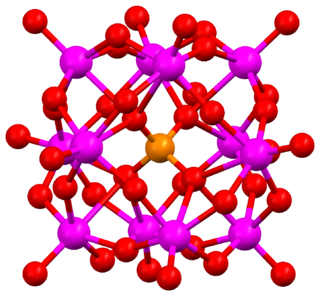Related Research Articles

In geology and mineralogy, a mineral or mineral species is, broadly speaking, a solid substance with a fairly well-defined chemical composition and a specific crystal structure that occurs naturally in pure form.

The mineral pyrite ( PY-ryte), or iron pyrite, also known as fool's gold, is an iron sulfide with the chemical formula FeS2 (iron (II) disulfide). Pyrite is the most abundant sulfide mineral.

Chalcopyrite ( KAL-kə-PY-ryte, -koh-) is a copper iron sulfide mineral and the most abundant copper ore mineral. It has the chemical formula CuFeS2 and crystallizes in the tetragonal system. It has a brassy to golden yellow color and a hardness of 3.5 to 4 on the Mohs scale. Its streak is diagnostic as green-tinged black.

Jarosite is a basic hydrous sulfate of potassium and ferric iron (Fe-III) with a chemical formula of KFe3(SO4)2(OH)6. This sulfate mineral is formed in ore deposits by the oxidation of iron sulfides. Jarosite is often produced as a byproduct during the purification and refining of zinc and is also commonly associated with acid mine drainage and acid sulfate soil environments.

Scheelite is a calcium tungstate mineral with the chemical formula CaWO4. It is an important ore of tungsten (wolfram). Scheelite is originally named after Swedish chemist Carl Wilhelm Scheele (1742–1786). Well-formed crystals are sought by collectors and are occasionally fashioned into gemstones when suitably free of flaws. Scheelite has been synthesized using the Czochralski process; the material produced may be used to imitate diamond, as a scintillator, or as a solid-state lasing medium. It was also used in radium paint in the same fashion as was zinc sulphide, and Thomas Edison invented a fluoroscope with a calcium tungstate-coated screen, making the images six times brighter than those with barium platinocyanide; the latter chemical allowed Röntgen to discover X-rays in early November 1895. Note, the semi-precious stone marketed as 'blue scheelite' is actually a rock type consisting mostly of calcite and dolomite, with occasional traces of yellow-orange scheelite.

Vivianite (Fe(II)
3(PO
4)
2·8H
2O) is a hydrated iron(II) phosphate mineral found in a number of geological environments. Small amounts of manganese Mn2+, magnesium Mg2+, and calcium Ca2+ may substitute for iron Fe2+ in its structure. Pure vivianite is colorless, but the mineral oxidizes very easily, changing the color, and it is usually found as deep blue to deep bluish green prismatic to flattened crystals. Vivianite crystals are often found inside fossil shells, such as those of bivalves and gastropods, or attached to fossil bone. Vivianite can also appear on the iron coffins or on the corpses of humans as a result of a chemical reaction of the decomposing body with the iron enclosure.

Powellite is a calcium molybdate mineral with formula CaMoO4. Powellite crystallizes with tetragonal – dipyramidal crystal structure as transparent adamantine blue, greenish-brown, yellow-to-grey typically anhedral forms. It exhibits distinct cleavage, and has a brittle-to-conchoidal fracture. It has a Mohs hardness of 3.5 to 4 and a specific gravity of 4.25. It forms a solid solution series with scheelite (calcium tungstate, CaWO4). It has refractive index values of nω=1.974 and nε=1.984.

Copiapite is a hydrated iron sulfate mineral with formula: Fe2+Fe3+4(SO4)6(OH)2·20(H2O). Copiapite can also refer to a mineral group, the copiapite group.

Vauxite is a phosphate mineral with the chemical formula Fe2+Al2(PO4)2(OH)2·6(H2O). It belongs to the laueite – paravauxite group, paravauxite subgroup, although Mindat puts it as a member of the vantasselite Al4(PO4)3(OH)3·9H2O group. There is no similarity in structure between vauxite and paravauxite Fe2+Al2(PO4)2(OH)2·8H2O or metavauxite Fe3+Al2(PO4)2(OH)2·8H2O, even though they are closely similar chemically and all minerals occur together as secondary minerals. Vauxite was named in 1922 for George Vaux Junior (1863–1927), an American attorney and mineral collector.

The Keggin structure is the best known structural form for heteropoly acids. It is the structural form of α-Keggin anions, which have a general formula of [XM12O40]n−, where X is the heteroatom, M is the addendum atom, and O represents oxygen. The structure self-assembles in acidic aqueous solution and is a commonly used type of polyoxometalate catalysts.

Plancheite is a hydrated copper silicate mineral with the formula Cu8Si8O22(OH)4•(H2O). It is closely related to shattuckite in structure and appearance, and the two minerals are often confused.

Zemannite is a very rare oxide mineral with the chemical formula Mg0.5ZnFe3+[TeO3]3·4.5H2O. It crystallizes in the hexagonal crystal system and forms small prismatic brown crystals. Because of the rarity and small crystal size, zemannite has no applications and serves as a collector's item.

Christite is a mineral with the chemical formula TlHgAsS3. It is named after Dr. Charles L. Christ, a member of the U.S. Geological Survey. It usually comes in a crimson red or bright orange color. It has a density of 6.2 and has a rating between 1 and 2 on Mohs Hardness Scale. Christite has an adamantine luster and leaves behind an orange streak. Its crystal system is monoclinic with possible crystal classes of twofold symmetry, mirror plane symmetry, and twofold with a mirror plane. This means it can have radial symmetry, mirror plane symmetry, or mirror plane symmetry perpendicular to the two-fold axis. It is an anisotropic mineral, which means that it exhibits different properties when measured in different directions. In plane polarized light, its color is golden yellow. It is birefringent, which means that it has two distinct indices of refraction. This can be seen when one looks through the microscope with both polars crossed and sees the mineral change colors when it is rotated.

Tsumcorite is a rare hydrated lead arsenate mineral that was discovered in 1971, and reported by Geier, Kautz and Muller. It was named after the TSUMeb CORporation mine at Tsumeb, in Namibia, in recognition of the Corporation's support for mineralogical investigations of the orebody at its Mineral Research Laboratory.

Ianbruceite is a rare hydrated zinc arsenate with the formula [Zn2(OH)(H2O)(AsO4)](H2O)2; material from the Driggith mine has traces of cobalt. It was first discovered at Tsumeb, approved by the International Mineralogical Association as a new mineral species in 2011, reference IMA2011-49, and named for Ian Bruce, who founded "Crystal Classics" in the early 1990s, and was heavily involved in attempts to reopen the famous Tsumeb mine for specimen mining.
In 2013 new occurrences of ianbruceite were reported from the neighbouring Driggith and Potts Gill mines on High Pike in the Caldbeck Fells, Cumbria, England. Here the mineral is probably a post-mining product. Caldbeck Fells and Tsumeb are the only reported localities for ianbruceite to date (May 2013).

Köttigite is a rare hydrated zinc arsenate which was discovered in 1849 and named by James Dwight Dana in 1850 in honour of Otto Friedrich Köttig (1824–1892), a German chemist from Schneeberg, Saxony, who made the first chemical analysis of the mineral. It has the formula Zn3(AsO4)2·8H2O and it is a dimorph of metaköttigite, which means that the two minerals have the same formula, but a different structure: köttigite is monoclinic and metaköttigite is triclinic. There are several minerals with similar formulae but with other cations in place of the zinc. Iron forms parasymplesite Fe2+3(AsO4)2·8H2O; cobalt forms the distinctively coloured pinkish purple mineral erythrite Co3(AsO4)2·8H2O and nickel forms annabergite Ni3(AsO4)2·8H2O. Köttigite forms series with all three of these minerals and they are all members of the vivianite group.

Carminite (PbFe3+2(AsO4)2(OH)2) is an anhydrous arsenate mineral containing hydroxyl. It is a rare secondary mineral that is structurally related to palermoite (Li2SrAl4(PO4)4(OH)4). Sewardite (CaFe3+2(AsO4)2(OH)2) is an analogue of carminite, with calcium in sewardite in place of the lead in carminite. Mawbyite is a dimorph (same formula, different structure) of carminite; mawbyite is monoclinic and carminite is orthorhombic. It has a molar mass of 639.87 g. It was discovered in 1850 and named for the characteristic carmine colour.

Rakovanite, (NH4)3Na3(V10O28) · 12H2O; formerly given as Na3(H3V10O28).15H2O; later, the ammonium ion was shown to be present and essential, is a member of the pascoite family. It is a transparent, brittle mineral occurring in the monoclinic crystal system. It is orange in color and has an orange-yellow colored streak. Rakovanite is soft with a Mohs hardness of 1 and a calculated density of 2.407g cm−3. It does not fluoresce in long- or short-wave ultraviolet radiation. Rakovanite crystals are up to one mm in maximum dimension and vary in habit from blocky to prismatic on [001], commonly exhibiting steps and striations parallel to [001]. Its name honors John Rakovan, former professor, Department of Geology and Environmental Earth Science, Miami University, State Mineralogist and Senior Museum Curator, New Mexico Bureau of Geology and Mineral Resources.
Scandiobabingtonite was first discovered in the Montecatini granite quarry near Baveno, Italy in a pegmatite cavity. Though found in pegmatites, the crystals of scandiobabingtonite are sub-millimeter sized, and are tabular shaped. Scandiobabingtonite was the sixth naturally occurring mineral discovered with the rare earth element scandium, and grows around babingtonite, with which it is isostructural, hence the namesake. It is also referred to as scandian babingtonite. The ideal chemical formula for scandiobabingtonite is Ca2(Fe2+,Mn)ScSi5O14(OH).

Segnitite is a lead iron(III) arsenate mineral. Segnitite was first found in the Broken Hill ore deposit in Broken Hill, New South Wales, Australia. In 1991, segnitite was approved as a new mineral. Segnitite has since been found worldwide near similar locality types where rocks are rich in zinc and lead especially. it was named for Australian mineralogist, gemologist and petrologist Edgar Ralph Segnit. The mineral was named after E. R. Segnit due to his contributions to Australian mineralogy.
References
- ↑ Warr, L.N. (2021). "IMA–CNMNC approved mineral symbols". Mineralogical Magazine. 85 (3): 291–320. Bibcode:2021MinM...85..291W. doi: 10.1180/mgm.2021.43 . S2CID 235729616.
- 1 2 3 4 5 6 7 Anthony R. Kampf, John M. Hughes, Barbara P. Nash, Stephen E. Wright, George R. Rossman, Joe Marty; Ophirite, Ca2Mg4[Zn2Mn23+(H2O)2(Fe3+W9O34)2]·46H2O, a new mineral with a heteropolytungstate tri-lacunary Keggin anion. American Mineralogist 2014;; 99 (5-6): 1045–1051. doi: https://doi.org/10.2138/am.2014.4699.
- 1 2 3 Hudson Institute of Mineralogy, 2014, Ophirite: https://www.mindat.org/min-43845.html (accessed November 2023)